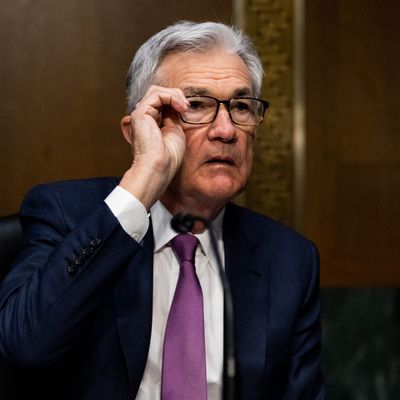
When the federal government releases its December inflation report tomorrow, no matter what it says — whether it’s a new 21st-century record or a surprise flattening of consumer prices — the stakes for the economy couldn’t be higher, and the headline number will set the tone for the rest of 2022, if not beyond. It was scarcely a month ago that President Biden predicted that last month’s Consumer Price Index, the government’s inflation report, had peaked at a 6.8 percent annual increase on an oil-price spike. But now economists are betting on no such relief after the Omicron variant spread rapidly throughout the country, disrupting the supply chains that have been under strain throughout the pandemic. More than just about anything else, this inflation report will give the Federal Reserve a start date to suck money — and, potentially, jobs — out of the system in a bid to keep prices from spiraling further out of control.
The Fed cares about two things: inflation and employment. Right now, inflation appears to be getting worse, and the overall workforce — while weirder than it usually is because of the pandemic — is doing a lot better. Last month, the unemployment rate fell to 3.9 percent, as close to full employment during the pandemic era as we’ve gotten, and far better than April 2020, when more than one in seven American workers were out of a job. Whether this is really as great as it sounds is up for debate: There are still millions of people who are out of the workforce entirely due to child-care or health concerns, and if the Fed starts to make borrowing costs more expensive — at a time when child tax credits have lapsed and savings have flatlined — that could end up hurting the overall economy. Wednesday’s inflation number will be a key data point in deciding how urgently Jerome Powell has to tighten. (It’s looking like the answer might be ASAP.)
Powell made it plain on Tuesday that getting those people back into the workforce just isn’t as much of a priority for him anymore as taming inflation is, arguing that rising prices could end up crushing jobs in the long run. “To get the kind of very strong labor market we want with high participation, it’s going to take a long expansion,” he said during his Senate confirmation hearing. “We can see that participation is moving only very slowly, and to get a long expansion, we’re going to need price stability. So, in a way, high inflation is a severe threat to the achievement of maximum employment into achieving a long expansion that can give us.” This has been the clearest signal yet that the Fed is going to move aggressively to tighten the economy, something that’s been increasingly evident since the start of the year. “Inflation has accelerated so much more than the Fed had expected that they’re less patient to figure out what’s actually going on in the labor market than they were previously,” Megan Greene, global chief economist for the Kroll Institute and a senior fellow at the Harvard Kennedy School, told me on Monday.
What this means is that, one way or another, we’re at the beginning of the end stages of the pandemic-era economy, with its $5 trillion in stimulus and about two years of rock-bottom borrowing rates. To put it another way, it’s going to get harder to have money from here on out. Goldman Sachs predicted the Fed will hike rates four times next year starting in March, and Jamie Dimon, the longtime CEO of JPMorgan Chase, said it could be even more than that. Powell isn’t alone in thinking that the economy will be able to handle any hikes in interest rates, but the biggest risks are for the people still living in the most precarious situation: those who can’t work as much as they want or are already borrowing to get by. By continuing to wait for them to jump back into the workforce, he argued, the economy could end up punishing everyone else. It’s unclear if this tactic will actually push people to go back into the labor market, but the Fed chair has made it clear that his patience is running out.






























